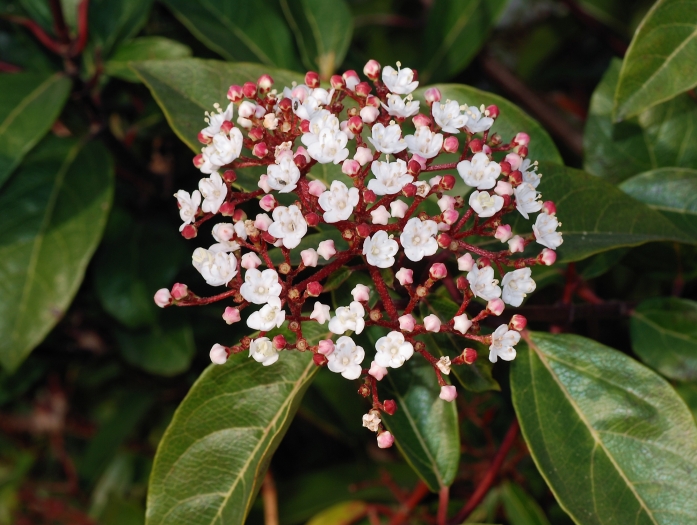Laurustinus
(Viburnum tinus)
Laurustinus (Viburnum tinus)
/
/

Alvesgaspar
CC BY-SA 3.0
Image By:
Alvesgaspar
Recorded By:
Copyright:
CC BY-SA 3.0
Copyright Notice:
Photo by: Alvesgaspar | License Type: CC BY-SA 3.0 | License URL: https://creativecommons.org/licenses/by-sa/3.0 | Uploader: Alvesgaspar | Publisher: Wikimedia Commons | Title: Viburnum_February_2008-1.jpg | Notes: {{Information |Description={{en|1=View of 3-month old bambara nut (Vigna subterranea) in field, Kelongwa Village, Kasempa District, Northwestern Province, Zambia.}} |Source=Own work by uploader |Author=[[User:Kkibumba|Kkibumba]] |Date=2005-02-15 |Permissi |

















































































Estimated Native Range
Summary
Viburnum tinus, commonly known as Laurustinus, is an evergreen shrub native to the Mediterranean region, including forests and coastal sage scrub areas. It typically grows to 2–7 m (7–23 ft) in height and up to 3 m (10 ft) in width, forming a dense, rounded crown. The leaves are dark green, ovate, and persist for 2–3 years. Small, white or light pink flowers bloom from reddish-pink buds in dense cymes 5–10 cm in diameter during winter, with a flowering period extending from October to June in the northern hemisphere. While some find the fragrance of the flowers strong, especially after rain, others may find it offensive. The flowers are monoecious and pentamerous, with five tubular petals that transition from pink in the bud to white. Noteworthy is the dark blue-black drupe fruit, 5–7 mm long, which exhibits a rare structural color due to microscopic fat globules, contributing to its metallic blue hue.
Laurustinus is valued for its winter blooms and attractive berries, making it a popular choice for ornamental planting in gardens, hedges, and as a foundation plant. It is hardy down to −10 °C (14 °F) and adaptable to various soil types with slow, medium, or fast drainage. Full sun is ideal, but it can tolerate part shade. The cultivars ‘Eve Price’, ‘French White’, and ‘Gwenllian’ have received the Royal Horticultural Society’s Award of Garden Merit. However, gardeners should be cautious as Viburnum tinus can become invasive outside its native range, particularly in the United States.CC BY-SA 4.0
Laurustinus is valued for its winter blooms and attractive berries, making it a popular choice for ornamental planting in gardens, hedges, and as a foundation plant. It is hardy down to −10 °C (14 °F) and adaptable to various soil types with slow, medium, or fast drainage. Full sun is ideal, but it can tolerate part shade. The cultivars ‘Eve Price’, ‘French White’, and ‘Gwenllian’ have received the Royal Horticultural Society’s Award of Garden Merit. However, gardeners should be cautious as Viburnum tinus can become invasive outside its native range, particularly in the United States.CC BY-SA 4.0
Plant Description
- Plant Type: Shrub
- Height: 6-12 feet
- Width: 2-4 feet
- Growth Rate: Rapid
- Flower Color: Pink, White
- Flowering Season: Spring, Winter
- Leaf Retention: Evergreen
Growth Requirements
- Sun: Full Sun, Part Shade
- Water: Medium
- Drainage: Slow, Medium, Fast
Common Uses
Bank Stabilization, Bee Garden, Bird Garden, Border Plant, Butterfly Garden, Deer Resistant, Drought Tolerant, Fragrant, Hedges, Hummingbird Garden, Rabbit Resistant, Salt Tolerant, Showy Flowers, Street Planting
Natural Habitat
Mediterranean region, including forests and coastal sage scrub areas
Other Names
Common Names: Laurustine, Laurestine
Scientific Names: , Viburnum tinus, Viburnum lucidum, Viburnum rugosum, Viburnum tinus var. lucidum, Viburnum tinus var. hirtum, Tinus laurifolius, Tinus lauriformis, Tinus lucidus, Tinus rugosus
GBIF Accepted Name: Viburnum tinus L.